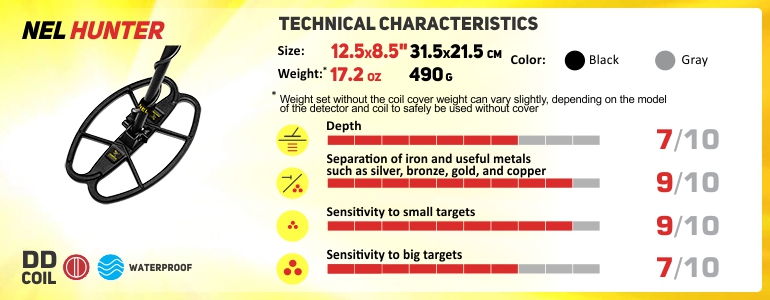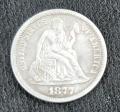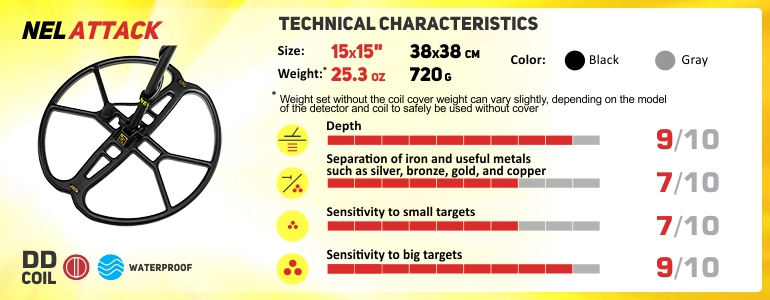OverviewAs you may know I just took delivery of 2 new NEL coils yesterday-the Hunter (8.5"x12.5" DD) and Attack (15" DD). NEL coils out of Kharkov, Ukraine are not factory authorized by minelab. I suspect they were reverse engineered for the circuitry and programming in the coil, then greatly improved upon. I think this is a leftover trait from the soviet era when most any products available were poor quality and unreliable, and even now modern technology is often scarce. The coil feels very solid well built, but still very light weight. The package included the coil, cap for the cord end, plactic bolt and nut. Also included were new lower rod grommets for mounting the coil and a velcro strap for retaining the cord
Anyone familiar with the X-Terra 505 or 705 knows they can be run at 3 KHz, 7.5 KHz or 18.75 KHz., while the 305 only uses the 2 higher frequencies, and switching to 3 KHz will give a coil fail fault. Normally, to change frequencies you have to change coils which becomes extremely expensive quite fast, not to mention the inconvenience of traveling with all the extra coils if going on a trip and the fact that there are not a whole lot of coils to choose from between Minelab and Coiltek.
Switching frequencies on the NEL multiple frequency coil is as easy as powering the detector off and back on again within 3 seconds. This will toggle the coil to the next frequency in progression. Powering off more than 3 seconds, the coil will maintain the last frequency used.
First run of the Hunter Coil
To try the coils for the first time, I selected the smaller Hunter coil to use at a new park. New meaning it's only a couple years old, but was built at an old farm site where the old barn was re-purposed into a concession stand and open use hall. (Edit-after searching aerial photos I found the old barn actually was razed around 1995). I had hopes that some old items from the farm might yet remain to be detected, but unfortunately this was not the case. The park area apparently had all the top soil removed, then had a deep layer of gravel put in and new top soil spread maybe 3 inches deep over the gravel. I don't know yet the extent of this gravel field, but suspect there may be old nails and trash well under the gravel layer.
I started out with the 3 KHz frequency because frankly, I was dying to see how this frequency worked compared to the other 2 I had already used extensively. I left the settings the same from using the minelab 10.5"DD coil previously to give a starting reference point to compare to. The sensitivity was set to 24, as anything higher made the minelab coil chatty and give false signals even in the air. Right away I started getting deep trash signals, but nothing else. I had suspected being near the concession stand and parking lot I would get a lot of pennies at least. Eventually I got a couple dimes dig out-strong signals, about 3 inches deep with accurate VDI. While digging the second dime I got another signal on my pinpointer and ran my detector over the spot, but got nothing. What the heck I thought. I raised the coil up a couple inches or so and finally got the penny signal. Also it either ignores or can't see lower conductivity items at shallow depths. Once I lowered the sensitivity to 14, I could air test a penny to about 8-10 inches yet get the surface signals clearly. But once I dropped the sensitivity, I started getting a lot of near surface junk like can slaw and pulltabs I wasn't seeing before.
Now switching to 7.5 KHz and upping the sensitivity back to 24, I tried overlapping some of the areas I already detected. This time I had no problem getting the surface pennies and all the other trash I didn't see before. I did manage to find a small coin spill of clad-being a quarter and a couple pennies, but nothing else of note. At this frequency it acts much like the minelab coil, but much more stable and seems to run a lot deeper.
Conclusion
In conclusion, what I found is that this coil at 3 KHz is insanely DEEP! I think this will be an awesome coil for trashy areas where the garbage is in the top couple inches while coil only sees the good stuff underneath. This frequency should be a total silver magnet as it loves higher conductivity targets. At 7.5 KHz this coil should be great for all around general detecting. It still gets great depth, separates targets well, and it should find gold rings as easily as small silver items. I did not try the coil much at 18.75 KHz as I am not seeking flakes of gold or hunting over black sand or high mineralization yet. But I highly suspect this coil will perform well above expectations and find targets that were not able to be seen before.
I will post a review of the 15" Attack coil when I have the opportunity to test it out.






 Reply With Quote
Reply With Quote It didn't take more than about 20 minutes of practice to really get used to the big coil and start enjoying it's capabilities. I managed to find tons of clad, and even a "13" off a tassel likely from that year's graduation. So it does pick up small items well. Coins are loud and clear, even if they are angled or on edge. Separation is awesome-I did find a coin mostly hidden under a rusty piece if metal only leaving a small sliver if coin exposed. The field may be long, but seems razor thin for surgical accuracy!
It didn't take more than about 20 minutes of practice to really get used to the big coil and start enjoying it's capabilities. I managed to find tons of clad, and even a "13" off a tassel likely from that year's graduation. So it does pick up small items well. Coins are loud and clear, even if they are angled or on edge. Separation is awesome-I did find a coin mostly hidden under a rusty piece if metal only leaving a small sliver if coin exposed. The field may be long, but seems razor thin for surgical accuracy!



